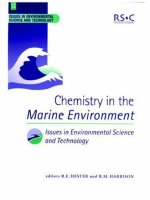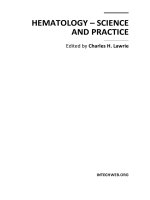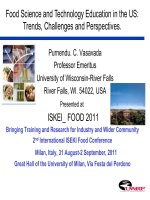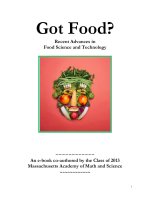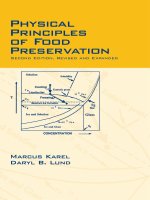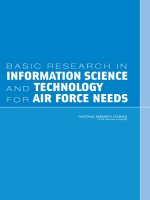Advances in food science and technology edited by visakh p m et al volume 1
Bạn đang xem bản rút gọn của tài liệu. Xem và tải ngay bản đầy đủ của tài liệu tại đây (5.17 MB, 319 trang )
Advances in Food Science
and Technology
Scrivener Publishing
100 Cummings Center, Suite 541J
Beverly, MA 01915-6106
Publishers at Scrivener
Martin Scrivener ()
Phillip Carmical ()
Advances in
Food Science
and Technology
Edited by
Visakh P. M., Sabu Thomas, Laura B.
Iturriaga, and Pablo Daniel Ribotta
#
>
Scrivener
Publishing
Publi
WILEY
Copyright © 2013 by Scrivener Publishing LLC. All rights reserved.
Co-published by John Wiley & Sons, Inc. Hoboken, New Jersey, and Scrivener Publishing
LLC, Salem, Massachusetts.
Published simultaneously in Canada.
No part of this publication may be reproduced, stored in a retrieval system, or transmitted in
any form or by any means, electronic, mechanical, photocopying, recording, scanning, or otherwise, except as permitted under Section 107 or 108 of the 1976 United States Copyright Act,
without either the prior written permission of the Publisher, or authorization through payment
of the appropriate per-copy fee to the Copyright Clearance Center, Inc., 222 Rosewood Drive,
Danvers, MA 01923, (978) 750-8400, fax (978) 750-4470, or on the web at www.copyright.com.
Requests to the Publisher for permission should be addressed to the Permissions Department,
John Wiley & Sons, Inc., I l l River Street, Hoboken, NJ 07030, (201) 748-6011, fax (201) 748-6008,
or online at http: / /www. wiley.com/ go /permission.
Limit of Liability/Disclaimer of Warranty: While the publisher and author have used their
best efforts in preparing this book, they make no representations or warranties with respect
to the accuracy or completeness of the contents of this book and specifically disclaim any
implied warranties of merchantability or fitness for a particular purpose. No warranty may
be created or extended by sales representatives or written sales materials. The advice and
strategies contained herein may not be suitable for your situation. You should consult with a
professional where appropriate. Neither the publisher nor author shall be liable for any loss
of profit or any other commercial damages, including but not limited to special, incidental,
consequential, or other damages.
For general information on our other products and services or for technical support, please
contact our Customer Care Department within the United States at (800) 762-2974, outside the
United States at (317) 572-3993 or fax (317) 572-4002.
Wiley also publishes its books in a variety of electronic formats. Some content that appears in
print may not be available in electronic formats. For more information about Wiley products,
visit our web site at www.wiley.com.
For more information about Scrivener products please visit www.scrivenerpublishing.com.
Cover design by Russell Richardson
Library of Congress Cataloging-in-Publication
ISBN 978-1-118-12102-3
Printed in the United States of America
10
9 8 7 6 5 4 3 2 1
Data:
Contents
Preface
List of Contributors
1
2
Food Chemistry and Technology
Visakh P. M., Sabu Thomas, Laura B. Iturriaga
and Pablo Daniel Ribotta
1.1 Food Security
1.2 Nanotechnology in Food Applications
1.3 Frozen Food and Technology
1.4 Chemical and Functional Properties of
Food Components
1.5 Food: Production, Properties and Quality
1.6 Safety of Enzyme Preparations Used in Food
1.7 Trace Element Speciation in Food
1.8 Bio-nanocomposites for Natural Food Packaging
References
Food Security: A Global Problem
Donatella Restuccia, Umile Gianfranco
Spizzirri,
Francesco Puoci, Giuseppe Cirillo, Ortensia Ilaria Parisi,
Giuliana Vinci and Nevio Picci
2.1 Food Security: Definitions and Basic Concepts
2.2 Main Causes of Food Insecurity
2.2.1 Social Issues
2.2.2 Economic Issues
2.2.3 Environmental Issues
2.3 The Food Insecurity Dimension
2.3.1 Current Situation at Global Level
2.3.2 The Food, Financial and Economic Crisis and
Their Implications on Food Security
xi
xv
1
1
4
5
7
8
10
11
13
14
19
20
27
28
36
41
50
50
55
CONTENTS
2.3.3
2.3.4
The Last Concern: Food Prices Volatility
The Food Sector Numbers: Trends in Global
Food Production and Trade
2.4 Conclusions
References
65
72
93
95
Nanotechnology in Food Applications
Rut M. S. Cruz, Javiern F. Ruhilar, Igor Khmelinskii
and Margarida C. Vieira
3.1 What is Nanotechnology?
3.2 Food Formulations
3.3 Food Packaging
3.3.1 Enhanced Barrier Properties
3.3.2 Active Packaging
3.3.3 Intelligent Packaging
3.4 Regulation Issues and Consumer Perception
Acknowledgements
References
103
Frozen Food and Technology
Elisabete M.C. Alexandre, Teresa R.S. Brandäo
and Cristina L.M. Silva
4.1 Introduction
4.2 Treatments: Pre-freezing
4.2.1 Fruits and Vegetables
4.2.2 Fish Products
4.2.3 Meat Products
4.3 Freezing Process
4.4 Freezing Methods and Equipment
4.4.1 Freezing by Contact with Cold Air
4.4.2 Freezing by Contact with Cold Liquid
4.4.3 Freezing by Contact with Cold Surfaces
4.4.4 Cryogenic Freezing
4.4.5 Combination of Freezing Methods
4.4.6 Innovations in Freezing Processes
4.4.7 Food Products and Freezing Methods
4.5 Effect of Freezing and Frozen Storage on Food
Properties
4.5.1 Physical Changes
4.5.2 Chemical Changes
4.5.3 Microbiological Aspects
123
103
105
107
107
112
114
115
116
116
124
125
125
127
128
129
131
131
135
135
136
137
137
139
142
142
143
145
CONTENTS
4.6 Final Remarks
References
Chemical and Functional Properties of Food
Components
Campos-Montiel R.G., Pimentel-GonzalezD.J.
and
FtgueiraA.C.
5.1 Introduction
5.2 Functional and Chemical Properties of
Food Components
5.2.1 Functional Foods: Historical Perspective
and Definitions
5.2.2 Legislation on Functional Food Claims
5.2.3 Classification of Functional Foods
5.2.4 Functional Properties of Food Components
5.3 Nutritional Value and Sensory
Properties of Food
5.3.1 Nutritional Value of Food
5.3.2 Sensory Properties of Food
5.4 Postharvest Storage and Processing
5.4.1 Bioactive Compounds Postharvest
5.5 Conclusion
Acknowledgements
References
Food: Production, Properties and Quality
Yantyatt Widyastuti, Tattk Khusntati
and Endang Sutriswati Rahayu
6.1 Introduction
6.2 Food Production
6.3 Factors Affecting Production and Improvement
of Food
6.3.1 Soil and Climate
6.3.2 Population and Income Per Capita
6.3.3 Technology
6.3.4 Plant Source Foods
6.3.5 Animal Source Foods
6.4 Food Properties
6.5 Food Quality
References
vii
146
147
151
151
152
152
153
161
162
168
169
172
174
174
177
178
178
185
185
186
187
187
188
188
191
193
196
197
199
viii
CONTENTS
Regulatory Aspects of Food Ingredients in the United
States: Focus on the Safety of Enzyme Preparations
Used in Food
Shayla West-Barnette and Jannavi R. Srinivasan
7.1 Introduction
7.2 Regulatory History of Food Ingredients: Guided
by Safety
7.3 Scientific Advancement as Part of the Regulatory
201
202
202
History of Enzyme Preparations
7.4 Safety Evaluation of Enzyme Preparations
7.4.1 Identity of the Enzyme
7.4.2 Manufacturing Process and Composition
7.5 Conclusion
Acknowledgements
References
206
216
216
219
223
223
223
Trace Element Speciation in Food
Paula Berton, Estefania M. Martinis
and Rodolfo G. Wuilloud
8.1 Introduction
8.2 Implications of Toxic Elements Speciation
for Food Safety
8.2.1 Arsenic
8.2.2 Mercury
8.2.3 Tin
8.2.4 Chromium
8.2.5 Cadmium
8.3 Elemental Species and Its Impact on the
Nutritional Value of Food
8.3.1 Selenium
8.3.2 Iron
8.3.3 Cobalt
8.3.4 Zinc
8.4 Elemental Species in Food Processing
8.5 Potential Functional Food Derived from Health
Benefits of Elemental Species
8.5.1 Selenium
8.5.2 Iron and Zinc
227
228
230
231
234
235
236
237
238
238
240
241
242
243
246
246
247
CONTENTS
8.6
Analytical Methods for Food Elemental
Speciation Analysis
8.6.1 Species Separation
8.6.2 Species Detection: Elemental and Molecular
8.7 Conclusions
References
Bionanocomposites for Natural Food Packing
Bibin Mathew Cherian, Gabriel Molina de Olyveira,
Ligia Maria Manzine Costa, Alcides Lopes Leäo,
Marcia Rodrigues de Morais Chaves,
Sivoney Ferreira de Souza and Suresh Narine
9.1 Introduction
9.2 Natural Biopolymer-based Films
9.2.1 Polysaccharide Films
9.2.2 Protein Films
9.3 Modification of Film Properties
9.3.1 Natural Nanoreinforcements
9.3.2 Cellulose-based Nanoreinforcements
9.3.3 Starch Nanocrystals/Starch Nanoparticles
9.3.4 Chitin/Chitosan Nanoparticles
9.3.5 Plant-Protein Nanoparticle
9.3.6 Plasticizers
9.3.7 Clays
9.3.8 Active Agents
9.4 Environmental Impact of Bionanocomposites
Materials
9.4.1 Safety and Toxicology
9.4.2 Biodegradability and Compostability
9.5 Conclusions and Future Perspectives
References
Index
ix
249
249
253
256
257
265
266
267
268
270
274
274
275
282
283
285
286
288
290
290
291
293
294
294
301
Preface
"Advances in Food Science and Technology" summarizes many of
the recent technical research accomplishments in the area of food
science and technology, such as food security as a global problem,
nanotechnology in food application, frozen food and technology
food: production, properties & quality, trace element speciation in
food, bionanocomposites for food packing application etc. It is written
in a systematic and comprehensive manner and recent advances
in the developments in food science area and food technologies are
discussed here in detail. Therefore, the content of the current book
is unique. It covers an up-to-date record on the major findings and
observations in the field of food science and food technology and
it is intended to serve as a "one stop" reference resource for important research accomplishments in this area. The various chapters
in this book are contributed by prominent researchers from
industry, academia and government/private research laboratories
across the globe. This book will be a very valuable reference source
for university and college faculties, professionals, post-doctoral
research fellows, senior graduate students, food science technologists and researchers from R&D laboratories working in the area of
food science.
The first chapter on food chemistry and technology gives an
overview of the area of food science and technology such as food
security a global problem, nanotechnology in food application, frozen food and technology food: production, properties & quality,
trace element speciation in food, bionanocomposites for food packing application. This chapter is very essential for the beginners in
these fields since it provides a basic yet thorough understanding of
the food science field.
The following chapter provides an overview on food security as
a global problem. The first part of this chapter reviews food security: definitions and basic concepts, main causes of food insecurity
including social issues, economic issues, environmental issues and
XI
xii
PREFACE
later in the chapter, the authors explain the various aspects of the
food insecurity dimension such as current situation at global level,
financial and economic crisis and their implications on food security Lastly, they look at food prices volatility, food sector numbers:
trends in global food production and trade.
A survey on nanotechnology in food application is tackled in
the third chapter. The authors concentrate on the importance of
nanotechnology in food science, applications and also address
some of the challenges. This chapter also brings out new innovative methods for food formulations and novel applications such as
food packaging, enhanced barrier, active packaging, and intelligent
packaging.
The fourth chapter on frozen food and technology comprises
several subtopics. The first topic looks at pre-freezing treatments
of different food products such as fruits, vegetables, fish, and meat
products. In the another topic, the authors explain about the freezing methods and equipment such as freezing by contact with cold
air, freezing by contact with cold liquid, freezing by contact with
cold surfaces, cryogenic freezing and combination of freezing methods. The last section of this chapter, the authors explain the effect
of freezing and frozen storage on food properties such as physical
changes, chemical changes, microbiological aspects
The following chapter on chemical and functional properties of
food components provides the basic understanding of food components, nutritional value and sensory, post harvest storage and processing. This chapter gives an overview of functional and chemical
properties of food components with some subtopics such as functional foods: historical perspective and definitions, legislation on
functional food claims, classification of functional foods and functional properties of food components.
Another chapter examines the new aspects on food production, food
properties and food quality. In this chapter the authors mainly focus on
the food production factors sSuch as, soil, climate, population, income
and technology, plant source foods and animal source foods.
The following chapter is based on regulatory aspects of food
ingredients in the United States with the focus on the safety of
enzyme preparations used in food. The authors explain the various aspects such as regulatory history of food ingredients, scientific
advancement as part of the regulatory history of enzyme preparations, safety evaluation of enzyme preparations, identity of the
enzyme and manufacturing process and composition.
PREFACE
xiii
In the chapter on trace element speciation in food, the authors
discuss the implications of toxic elements such as arsenic, mercury,
tin, chromium, cadmium on speciation for food safety. Elements
such as selenium iron, cobalt, zinc, impact on the nutritional value
of food are also discussed. Moreover, the authors examine the analytical methods for food elemental speciation analysis, species separation and species detection.
The book concludes with a chapter on bionanocomposites for
natural food packing which discusses the natural biopolymerbased films such as polysaccharide films and protein films. Sections
are given over to the modification of film properties such as natural
nanoreinforcements, cellulose-based nanoreinforcements, starch
nanocrystals/starch nanoparticles, chitin/chitosan nanoparticles,
plant-protein nanoparticle, plasticizers, clays and active agents.
The chapter concludes with a section on the environmental impact
of bionanocomposites materials, their safety and toxicology, biodegradability and compostability.
The editors of this unique volume would like to express their
sincere gratitude to all the contributors of this book, who made
excellent support to the successful completion of this venture. We
are grateful to them for the commitment and the sincerity they
have shown towards their contributions in the book. Without their
enthusiasm and support, the compilation of this book could not
have been realized. We would like to thank all the reviewers who
have taken their valuable time to make critical comments on each
chapter. We also thank the publisher Scrivener-Wiley for recognizing the demand for such a book, and for realizing the increasing
importance of the area of food science and technology.
Visakh. P. M
Sabu Thomas
Laura B.Iturriaga
Pablo Daniel Ribotta
January 1,2013
List of Contributors
Elisabete Alexandre obtained her PhD in food science and technology from the College of Biotechnology, Portuguese Catholic
University, Porto, Portugal, in 2011. She is currently working on
chemical and physical phenomena in foods during processing. She
has authored 2 book chapters, published 6 articles in referred international journals and co-authored 17 communications in scientific
meetings.
Paula Berton is a PhD student in analytical chemistry, and is
Laboratory Instructor at the National University of Cuyo, Mendoza,
Argentina. She has co-authored 13 papers and 2 book chapters. Her
research is focused on the use of ionic liquids for microextractionbased analytical methodologies for elemental speciation analysis.
Teresa R.S. Brandäo is a chemical engineer with a PhD in biotechnology from the College of Biotechnology, Portuguese Catholic
University. She is a researcher at the Centre for Biotechnology
and Fine Chemistry of the Portuguese Catholic University. Her
research interests have been focused on food processing, modelling quality and safety attributes of food products with emphasis
in statistical experimental design procedures. She authored 8 book
chapters, published 45 articles in referred international journals andco-authored more than 80 communications in scientific meetings.
Bibin Mathew Cherian is a scientist in the Department of Natural
Resources at Sao Paulo State University. He has a PhD in chemistry, MSc in analytical chemistry and BSc in industrial chemistry,
chemistry and mathematics. He is active in the field of biobased
nanoreinforcments, nanocomposites, nanomedicine, membranes
and medical implants.
xv
xvi
LIST OF CONTRIBUTORS
Ligia Maria Manzine Costa is a PhD scholar at the Federal
University of ABC. She has an MSc in materials engineering and
a BSc in chemistry. Her research interests include electrospinning,
polymeric nanofibers, resorbable polymers, bacterial cellulose,
natural rubber latex.
Marcia Rodrigues de Morais Chaves is a faculty member at
the University of Sagrado Coraỗao. She has a PhD in chemical
engineering, MSc in materials engineering and a BSc in chemistry.
Her research interests are in cellulose separation from different
vegetable fiber sources and agro-industrial waste, as well on fibercomposite polymers and environmental aspects of these materials.
Giuseppe Cirillo received his PhD in 2008 from the University of
Calabria, Italy. He is currently in a post-doctoral position at the
same university and a visiting researcher at IFW Dresden, Germany,
working on polymeric nanotechnologies and biomaterials. He is
the author and co-author of more than 60 publications and the coeditor of the book Antioxidant Polymers.
Rui M.S. Cruz holds a PhD in biotechnology-food science and
engineering. He works in the area of food preservation, particularly in active packaging to improve food products quality and
extend shelf-life. He has published 12 peer-reviewed papers, 6 book
chapters and 1 book edition, and he is also a reviewer for several
scientific journals in the area of food science and technology.
Gabriel Molina de Olyveira is a PhD scholar at the Federal
University of ABC. He has an MSc and BSc in materials engineering.
He has experience in the rubber industry and manufacturing
plastic packaging. His research interests include bioelectrochemistry, bionanotechnology, bionanocomposite and bionanomedicine.
Sivoney Ferreira de Souza is a PhD scholar at the Federal
University of ABC. She has an MSc in energy in agriculture and
BSc in chemical engineering. Her research interests include nanostructured materials especially cellulose nanofibers in biomédical
application.
Ana Cristina Figueira is a coordinating professor of chemistry at
the University of the Algarve, Portugal. Her scientific interests are
LIST OF CONTRIBUTORS
xvii
in food chemistry with a focus on food authenticity and the study
of bioactive components of food and food by-products. She has
co-authored 1 book, 7 book chapters and 11 scientific papers.
Igor Khmelinskii holds a PhD and Habilitation in chemistry. He
has authored more than 150 peer-reviewed papers and 5 book
chapters. His research interests include food analysis, photophysics, photochemistry, magnetic field effects, and climate change.
Tatik Khusniati is a senior food microbial biochemist, awarded
as PhD from Hokkaido University, Japan in 2008. For the past
18 years she has been developing more intensive dairy foodmicrobial biochemistry research. She has a number of publications
both in national and international journals in relation to dairy
microbiology.
Alcides Lopes Leäo is a Professor of College of the Agricultural
Sciences at Sao Paulo State University. He has PhD in forestry, MSc
in energy in agriculture and a BSc in agricultural engineering. He
is the co-founder of ONG INFO, and International Natural Fibers
Organization, based in Amsterdam, the Netherlands. He is active
in the field of composites, natural fibers, recycling, biomass energy
and agricultural and municipal garbage.
Estefania Martinis holds a post-doc position at the National
University of Cuyo, Argentina. She is the co-author of 14 publications and 1 book chapter. She works in the field of development of
analytical methods for toxic elements determination at trace levels
using functionalized nanomaterials and ionic liquids.
Rafael German Campos Montiel is a researcher at the Autonomous
University of Hidalgo State, Argentina and has experience in extraction of bioactive compounds from microorganisms and plants used
as additives in foods. He has published 3 books, 8 chapters and
11 scientific papers in several journals. He has also worked in the
Hidalgo state government solving food industries problems.
Suresh Narine is the Ontario Research Chair in Green Chemistry
and Engineering and NSERC/GFO/ERS Industrial Research Chair
in Lipid Derived Biomaterials, is a professor of physics and astronomy and chemistry at Trent University and Director of the Trent
xviii
LIST OF CONTRIBUTORS
Centre for Biomaterials Research in Canada. He has a PhD in food
science, a MSc in condensed matter physics and a BSc in chemical
physics.
Ortensia Ilaria Parisi obtained her PhD in environment, health
and eco-friendly processes with a thesis on "Polymeric Materials
for Biomédical Applications: Synthesis and Characterisation".
Her research interests are in the areas of biomaterials, molecularly
imprinted polymers, graft polymers, functional polymers, stimuli
responsive hydrogels as well as functional foods and nutraceutics. She is author of more than 40 publications regarding the
above-mentioned topics.
Nevio Picci received his degree in chemistry in 1975 from the
University of Pisa and he is currently full professor in pharmaceutical
technology at the University of Calabria, Italy. His research interest
involves the application of functional polymers, biomaterials and
nanotechnologies in biomédical, pharmaceutical and food sciences.
He is the author and co-author of more than 150 publications.
Diana Pimentel is a researcher at the Autonomous University of
Hidalgo State, Argentina and has experience in food technology
with specific expertise encapsulating bioactive compounds and
probiotics. She has published 16 scientific papers in several journals.
She has received Pan-American and Latin-American awards for her
pioneering contributions recognized by international companies
like Bimbo and Kellogs.
Francesco Puoci earned his BS in chemistry from the University of
Calabria in 1999 and his PhD in 2002. His research activities focus
on the synthesis of polymeric functional materials for pharmaceutical and technological applications as well as functional foods and
nutraceutics.
Endang Sutriswati Rahayu is a senior lecturer at the Faculty of
Agricultural Technology, Gadjah Mada University, Yogyakarta,
Indonesia. She received her PhD in agricultural chemistry from the
University of Tokyo, Japan in 1991. Her research and publications are
mainly related to lactic acid bacteria (fermented foods and probiotics) and food safety (foodborne fungi and mycotoxin). She belongs
to several professional associations such as the Asian Federation
LIST OF CONTRIBUTORS
xix
Society for Lactic Acid Bacteria and the Indonesian Society for
Lactic Acid Bacteria, Microbiologist, and Food Technologist.
Javiera F. Rubilar is a researcher at the Department of Chemical
Engineering and Bioprocesses of the Pontificia Universidad Catolica
de Chile. She holds a PhD in chemistry and has published 3 peerreviewed papers. In 2011 she won third place in the best research
presentation award at the ISEKI Food conference.
Donatella Restuccia is an assistant professor of commodity sciences
at the Department of Pharmacy and Health and Nutrition Sciences
of the University of Calabria. Research activity is principally focused
on food quality and safety evaluation and in particular on the
determination of natural contaminates and bioactive compounds
in foods. She is the author or co-author of about 60 publications.
Cristina L.M. Silva is a chemical engineer with PhD in
Biotechnology from the College of Biotechnology, Portuguese
Catholic University. She is an associate professor at the College
of Biotechnology and a senior researcher at the Centre for
Biotechnology and Fine Chemistry of the Portuguese Catholic
University. She is the leader of a research team involved in thermal
and non-thermal food processing, focusing on process optimisation and development of strategies for food quality and safety. She
has authored 11 book chapters, published 80 articles in referred
international journals and co-authored more than 150 communications in scientific meetings.
U. Gianfranco Spizzirri received his PhD from the University
of Calabria in 2005. His research is focussed on the synthesis of
polymeric functional materials for technological applications.
Particular interest is devoted to development of specific experimental protocols in the evaluation of active components in nutraceutical
supplements and food matrices. He is the author and co-author of
more than 50 publications.
Jannavi Srinivasan is a review chemist in the FDA's Office of Food
Additive Safety. Her expertise includes bioengineered crops and
enzymes added to food. She has a PhD from Wayne State University
Detroit. She was a postdoctoral fellow at University of Michigan
and has worked for ten years in the industry.
xx
LIST OF CONTRIBUTORS
Margarida C Vieira is a Professor Coordinator (PhD) and Head of
the Department of Food Engineering (ISE-UAlg) since 2009. Her
main research area is innovative technologies for food preservation. She has published 16 peer-reviewed papers, 10 book chapters and edition of 2 books. In 1999 she won the first place in the
Product Development Division's Poster Competition at the IFT
Annual Meeting.
Giuliana Vinci is an associate professor of commodity science at
the Department of Management of Sapienza University of Rome.
The author of several publications (150) in national and international journals relating food quality, food security and sustainable
development.
Shayla West-Barnette is a consumer safety officer in FDA's Office
of Food Additive Safety where she serves on the Enzyme Review
Team as well as a microbiology reviewer. She holds a bachelor's
degree in biology from Bennett College and a PhD in microbiology
and immunology from Wake Forest University.
Yantyati Widyastuti is a highly distinguished animal nutritionist.
She obtained her PhD from Tokyo University of Agriculture, Japan
in 1989. She is a leader of animal nutrition research group and head
of Applied Microbiology laboratory in the Research Center for
Biotechnology, Indonesian Institute of Sciences. She has published
a number of papers in several international journals.
Rodolfo Wuilloud is a Professor at the National University of Cuyo
and Researcher at the National Council for Scientific and Technical
Research (CONICET) of Argentina. He is the author of 79 papers
and 3 book chapters. His research focuses on development of
analytical methods for elemental speciation based on microextraction techniques using ionic liquids and solid-phase preconcentration.
1
Food Chemistry and Technology
State of the Art, New Challenges and
Opportunities
Visakh P. M.1'2, Sabu Thomas 12 , Laura B. Iturriaga3 and
Pablo Daniel Ribotta4
Centre for Nanoscience and Nanotechnology, Mahatma Gandhi University,
Kottayam, Kerala, India
2
School of Chemical Sciences, Mahatma Gandhi University, Kottayam,
Kerala, India
institute of Chemical Sciences, Faculty of Agronomy, National University of
Santiago del Estero, Santiago del Estero, Argentina
department of Science and Technology, National University of Cordoba,
Cordoba, Argentina
Abstract
This chapter presents a brief account of the various categories of food
chemistry and technology along with the different parameters associated
with them. Included in the discussion of food chemistry and technology
are such issues as food security, nanotechnology in food applications, frozen food and technology, chemical and functional properties of food components, the production, properties and quality of food, safety of enzyme
preparations used in food, trace element speciation in food, bionanocomposites for natural food packing, etc.
Keywords: Food security, nanotechnology, frozen food, functional properties of food components, food production, trace element speciation in
food, food packing
1.1 Food Security
Nutritional status in food consumption is generally identified
by three indicators: calorie, protein, and fat intake while food
Visakh P. M., Sabu Thomas, Laura B. Iturriaga, and Pablo Daniel Ribotta (eds.) Advances in
Food Science and Technology, (1-18) © 2013 Scrivener Publishing LLC
1
2
ADVANCES IN FOOD SCIENCE AND TECHNOLOGY
consumption is mainly related with domestic food production and
food imports achieved by international trade. The concept of food
security has developed over the past three decades. Concerns about
food security up to the end of the 1970s were mostly directed at the
national and international level and concerned the ability of countries to secure adequate food supplies. It was only later that the
level of analysis shifted to include a focus on food security at local
level, even down to households and individuals [1].
Definitions of food security identify the outcomes of food security and are useful for formulating policies and deciding on actions,
but the processes that lead to desired outcomes also matter. Most
current definitions of food security therefore include references to
processes as well as outcomes and, taken together, these processes
constitute the complexity of the food system.
A variety of factors, both internal and external, affect the food
security of a country, and straightforward explanations for world
hunger should be treated with caution. Food security is, in fact,
a multifaceted concept that goes far beyond the number of people that can be sustained by the earth's limited food resources, to
encompass a broad range of aspects which are, however, related in
some fashion to two basic causes: insufficient national food availability and insufficient access to food by households and individuals. Population growth over the past century has been accompanied
by enormous increases in food production [2].
Among economic issues related with food insecurity, neglect
of agriculture and world trade rules are the most severe. Despite
the evidence that investment in agriculture results in growth and
poverty reduction, spending on agriculture as a share of total
public spending in developing countries fell by half between
1980 and 2004 [3]. By 2050 it is estimated that the world will need
to increase food production by 70 percent to feed a larger, more
urban, and, it is hoped, wealthier population [4, 5]. The Green
Revolution, and "industrialized" agriculture more generally, has
often been associated with problems of environmental degradation and pollution [6].
Trade and financial factors have been also considered as a driving force in food crisis. Although fundamental factors were clearly
responsible for shifting the world to a higher food price equilibrium in the years leading u p the 2008 food crisis, there is little
doubt that when food prices peaked in June of 2008, they soared
FOOD CHEMISTRY AND TECHNOLOGY
3
well above the new equilibrium price. By March 2009, prices of
staple grains had fallen by 30 percent from their peak in May 2008,
while energy prices fell by around 50 percent, before stabilizing
and then increasing again. At the moment, the global food prices
remain high, partly due to increasing fuel prices, and the World
Bank's Food Price Index is around its 2008 peak. However, the current global food price situation seems to possess both similarities
and differences with 2008 [7]. It is similar in four respects. First,
global grain stocks are low, driven by lower production. Second,
higher oil prices have impacted agricultural commodity prices, and
the recent events in the Middle East and North Africa add to the
current uncertainty. Crude oil prices underpin production costs of
agricultural products relying on fertilizers and petroleum, in particular in developed and emerging economies and transport costs
in many developing countries
The Eastern European countries, after recording bumper crops
in 2008, were unable to sustain potential growth in the subsequent years, and the 2010 drought led to substantially reduced
levels of crop production in the region. On the contrary, Latin
America and the Caribbean suffered weather-related production
shortfalls in 2008 but recovered in 2009 and 2010. In Asia, growth
in food production remained strong throughout the last decade,
generally in the range of 2-4 percent per year, although they faced
a slowdown in 2009 and 2010. Production failed to grow in 2009
in sub-Saharan Africa, which had seen growth in the range of
3-4 percent per year over the previous decade, while the region
registering the slowest growth in food production in recent years
is Western Europe. Production did increase in 2007 and 2008
under the effect of high prices and reduced set-aside requirements in the European Union, but declined by around 2 percent
in 2009 as a result of lower prices and unfavorable weather conditions. In this regard, the prospect for an expansion in grain
production in 2011 is particularly related with the expectation
of a return to regular climatic conditions firstly in the Russian
Federation, after last year's devastating dryness. Encouragingly,
the country has announced the lifting of its export ban from July
2011 and weather permitting, excellent crops are also anticipated
in Ukraine. However, other important producing regions (Europe
and North America) are now facing difficult weather situations
which eventually, may hamper yields.
4
ADVANCES IN FOOD SCIENCE AND TECHNOLOGY
1.2 Nanotechnology in Food Applications
Nanotechnology is an important tool that is influencing a large
number of industrial segments. The food industry is investing in
mechanisms and procedures to use nanotechnology to improve
production processes and produce food products with better and
more convenient functionalities [81.
One of the functions of food packaging is to increase the shelf
life of foods, protecting it from microbial and chemical contamination and other factors, such as oxygen and light. The use of nanotechnology in food packaging is a promising application aimed
at achieving longer shelf life of food products, rendering them
safer [9]. In 2006, about 400 companies around the world included
in the agricultural and food industry segment actively invested in
the research and development of nanotechnology, and by 2015 this
is expected to happen in more than 1,000 companies [10].
The use of nanomaterials in food formulations has the potential
to produce stronger flavorings, colorings, and nutritional additives,
and also improve production operations, lowering the costs of
ingredients and processing [11]. Nestlé reported that they recognize
the potential of nanotechnology to improve the properties of food
and food packaging. However, the company declares no research in
the field of nanotechnology [12].
New solutions can be provided for food packaging through the
modification of the permeability behavior of the packaging systems.
Some of these include: enhanced barrier (mechanical, microbial and
chemical), antimicrobial, and heat-resistance properties [13,14]. In
the late 1980s, the concept of polymer-clay nanocomposites (PCN)
was developed and first commercialized by Toyota [15], but only
since the late 1990s have works been published on the development
of PCN for food packaging [16].
There are different forms to improve the plastic materials' barrier.
One of them is the incorporation of clays or silicates in the polymer
matrix. These layered inorganic solids have drawn the attention of
the packaging industry due to their availability, low cost, significant enhancements and relatively simple processing [17].
Controlled release of active and bioactive compounds in food
packaging applications, and nanoencapsulation of functional
added-value food additives are other possible applications [18,19].
Metal and metal oxide nanoparticles and carbon nanotubes are the
FOOD CHEMISTRY AND TECHNOLOGY
5
nanoparticles most used for the development of active packaging
with antimicrobial properties [20].
Silver is the most common nanoadditive used in antimicrobial
packaging, with several advantages such as strong toxicity to a
wide range of microorganisms, high temperature stability and low
volatility [21].
Several mechanisms were proposed to explain the antimicrobial
properties of silver nanoparticles. The adhesion to the cell surface,
degrading lipopolysaccharides and forming "pits" in the membranes, largely increasing permeability [22], penetration inside
bacterial cell, damaging DNA; and releasing antimicrobial Ag + ions
by Ag-nanoparticles dissolution [23] are some of the proposed
hypotheses.
1.3 Frozen Food and Technology
Freezing is one of the oldest and most frequently used processes
for long-term food preservation. Nowadays, the freezing process is
strongly implemented worldwide, being one of the most common
preservation methods used for all kinds of commercialized foods:
fruits (whole, puréed or as juice concentrates) and vegetables; fish
fillets and seafood, including prepared dishes; meats and meat
products; baked goods (i.e., bread, cakes, pizzas); desserts and an
endless number of precooked dishes [24].
Food preservation by freezing occurs through different mechanisms. When temperature is lowered below 0°C, there is a reduction in the microbial loads and microbial activity; therefore, the
deterioration rate of foods decrease. Freezing temperatures affect
biological materials in various ways depending on their chemical
composition, microstructure and physical properties. The low temperatures also have a strong impact in enzymatic activity and oxidative reactions that help products avoid deterioration. In addition,
with ice crystal formation, less water will be available to support
deteriorative reactions and microbial viability [25,26].
Upon placing the food (whole or in pieces) in solutions of high
sugar or salt concentration, the water inside the food moves to the
concentrated solution and, simultaneously, the solute from the concentrated solution is transferred into the food. Osmotic concentration of fruits and vegetables prior to freezing improves their quality
6
ADVANCES IN FOOD SCIENCE AND TECHNOLOGY
in terms of color, texture and flavor, and the combination of this
treatment with partial air drying requires less energy consumption
than air drying alone [27,28].
The freezing process involves four main stages: (i) pre-freezing
stage - sensible heat is removed from the product, reducing the
temperature to the freezing point; (ii) super-cooling - temperature falls below the freezing point, which is not always observed;
(iii) freezing - latent heat is removed and water is transformed into
ice (i.e., crystallization) in all product; (iv) sub-freezing - the food
temperature is lowered to the storage temperature.
There are many factors that will determine the success of the
freezing operation. Freezing methods and type of equipment
used, composition and shape of product to be frozen, packaging
materials, freezing rates and ice crystallization, product moisture
content, specific heat, heat transfer coefficients and packaging, are
examples of factors that will determine freezing efficiency and
product quality.
In cryogenic freezing the food is in direct contact with the
refrigerant through three different ways: (i) the cryogenic liquid is
directly sprayed on the food in a tunnel freezer, (ii) the cryogenic
liquid is vaporized and blown over the food in a spiral freezer or
batch freezer, or (iii) the food product is immersed in cryogenic liquid in an immersion freezer. However, the most common method
used is the direct spraying of cryogenic solutions over the product
while it is conveyed through an insulated tunnel [29].
Jalté et al. [30] studied the effects of pulsed electric fields pretreatment on the freezing, freeze-drying and rehydration behavior
of potatoes, and concluded that the quality and rehydration of the
samples improved. LeBail et al. [31] reviewed the application of
high pressure in the freezing and thawing of foods. Alizadeh et al.
[32] froze salmon fillets by pressure shift freezing and verified that
ice crystals were smaller and more regular than the ones obtained
with conventional freezing methods.
During freezing, changes in temperature and concentration (due
to ice formation) play an important role in enzymatic and nonenzymatic reactions rates. Ice crystals may release the enclosed contents
of food tissues, such as enzymes and chemical substances, affecting
the product quality during freezing and frozen storage. The main
chemical changes verified during freezing and frozen storage are
related to lipid oxidation, protein denaturation, enzymatic browning
and degradation of pigments and vitamins.

